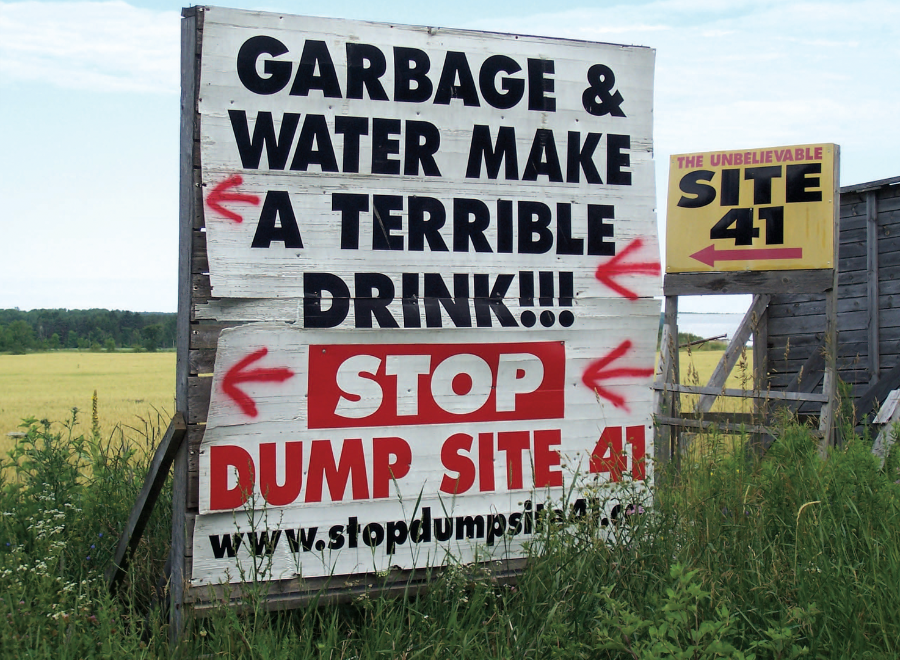Seventy-six-year-old Ina Wood was baking butter tarts last summer for an event at Ebenezer United near Midland, Ont., when the Ontario Provincial Police phoned. They ordered her and her husband, Keith, 84, to the Midland OPP detachment to be charged with defying a court order to stay away from a proposed dump site three kilometres from their home just east of Georgian Bay’s Wasaga Beach.
Ina put her half-finished tarts in the fridge and drove to Site 41, where Keith and others were still protesting despite the injunction. A fellow protester phoned police and negotiated a delay so the Woods could attend medical appointments already set for the next day.
You may unsubscribe from any of our newsletters at any time.
Then on Aug. 6, a Thursday morning, the couple drove to the station followed by a 100-car convoy. Everyone was cheering and clapping, says Ina, recalling her first-ever run-in with the law. “And when we came out, we were all laughing and socializing.”
But if Ina can call that moment “a big party,” it is only because the protesters were beginning to believe they might actually stop this dump from being constructed on top of an artesian spring identified as having some of the purest water on the planet.
And if they were finally seeing such possibilities at the 11th hour and 59th minute of a two-decade fight, it was mainly because people from disparate backgrounds — First Nations, cottagers, farmers, environmentalists and United Church people — had finally come together around their common cause.
“It’s unbelievable, in my view,” says Toronto lawyer Peter Rosenthal, who gave some legal assistance on this project and is known for his legal support of peace, environmental and Indigenous activists. The landfill at Site 41, just five kilometres north of Elmvale, Ont., “was in final construction last summer, and these people stopped it.” And this despite the fact the county had invested two decades and nearly $20 million to get it up and running.
It’s been a long struggle. In the mid-1980s, Simcoe County began talking about turning the 70 hectares of prime farmland known as Site 41 into a dump that would have received 1.6-million cubic metres of waste during its 34-year lifespan.
Ironically, in 1986, engineers chose Site 41 for basically the same reason local citizens oppose it: because it sits atop an artesian water source, the Alliston Aquifer. The water bubbling up from underground, engineers said, would act as a barrier to stop toxic chemicals from leaching into the soil and groundwater.
Progress was not straightforward, however. In 1989, the Environmental Review Tribunal and the Ontario Municipal Board jointly rejected the site, noting an “irredeemably deficient” selection process. Ontario premier David Peterson’s cabinet overturned that decision in 1990, however, and the county continued planning.
Then, in 2006, hydrogeologist William Shotyk tested water drawn from boreholes at the site and from nearby wells and found it to be as free of contaminants as Arctic glacier core samples that haven’t been exposed to the atmosphere for thousands of years. Something about the underground rock and gravel formations purifies the water phenomenally well.
North Simcoe residents and the Beausoleil First Nation have both opposed the dump since the beginning — but until recently, they worked independently. As it turns out, joining forces made all the difference. “We were doing everything right, but we just weren’t winning,” recalls Stephen Ogden, a local contractor and longtime dump opponent.
Things began to change in November 2008 when Mohawk artist and environmentalist Danny Beaton, who also has property in the area, got involved. At the time, the county, armed with a final certificate of approval for the dump site issued by the Ontario Ministry of the Environment, had begun preliminary construction. The plan was to start accepting garbage in the fall of 2009. But Beaton convinced Ogden and others to join him on an eight-day, 130-kilometre walk from Site 41 to Toronto. That drew national attention to the cause.
Soon after, Ebenezer United’s newly arrived interim minister, Rev. David Black, signed on. He initiated a resolution at the church, quickly passed, calling on the county and province to institute a 10-year moratorium on the dump. Eventually, the (aptly named) Living Waters Presbytery, Toronto Conference and last summer’s General Council also passed it.
The higher profile also caught the attention of renowned Canadian activist Maude Barlow and her Council of Canadians, who threw their support behind the cause, including helping local citizens organize a Walk for Water last May.
Vicki Monague, an Ojibwe woman from Beausoleil, participated in that walk, then took things up a notch. She and four other Ojibwe women, or Anishinabe Kweag, set up a protest vigil camp at one of the entrances to the site. They were joined by other local opponents, including Ina and Keith Wood, Danny Beaton and Beausoleil member John Hawk, who took responsibility for the sacred fire. He says a dream told him he would keep it lit until the dump was stopped.
The people of the Beausoleil First Nation live on Christian Island, explains Monague. “The health of Georgian Bay is what sustains our community. And the underground water flows from the site toward our island.” In her Anishinabe tradition, she adds, “Water is the life giver. It carries our babies for nine months. It is women’s responsibility to honour and safeguard it.”
Monague’s leadership inspired the Woods. But Monague says the church members’ support buoyed her spirits, too. “We worked with the local United Church and held amazing ceremonies,” she recalls. Both David Black and Christian Island United’s Rev. Bright Young were regular visitors to the camp, and their congregations upheld the protesters in prayer.
Perhaps most remarkable of all, recounts Monague, was the historic Midewiwin ceremony that traditional spiritual leaders held at the camp in early September. More than 100 people participated, she says, and most of them were non-Native, including several from Ebenezer United.
By mid-July 2009, a blockade initiated by the Anishinabe Kweag was disrupting work on the dump. The county obtained an injunction against the protest, and the Woods were arrested on Aug. 6 for defying it. The next day, police charged Monague and her new non-Anishinabe friend from the blockade Anne Ritchie-Nahuis — who had been actively opposing the dump since 2003.
Altogether, 18 people would be arrested and charged with mischief. The Woods later had their charges dismissed on compassionate grounds because of health problems. All other charges were eventually stayed on the condition that the protesters avoid the area for at least a year.
Then, on Sept. 22, victory. Facing mounting public opposition after the four-month camp and five-week blockade outside the gates, Simcoe County Council voted 26–3 to halt construction, though the dump was only weeks away from opening. In a 20-year fight, it was indeed the last minute.
There is a loophole, however. The county retains the provincial environment ministry’s certificate of approval for the facility. After municipal elections this fall, the incoming county council will not be bound by its predecessor’s decisions, notes Ogden. The certificate means a subsequent council could still open the dump or sell the land — appraised at $30 million to $50 million— to a private waste management company. “It’s very, very likely they will sell the land,” says Ogden. “Why wouldn’t they? The combination of the zoning and the certificate of approval makes it very valuable.”
Fresh from last fall’s victory, the protesters remain vigilant. Monthly potlucks continue to keep First Nations people, farmers, cottagers, churchgoers and environmentalists up to date, connected and ready for action.
Perhaps more important, the bonds and relationships forged last year mean residents and environmentalists stand united. So for now, the water still runs pure and clean at Site 41.
***
This story first appeared in The United Church Observer’s May 2010 issue with the title “True grit.”













